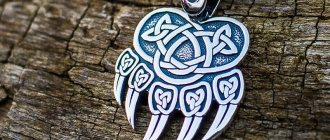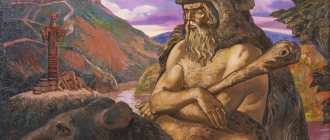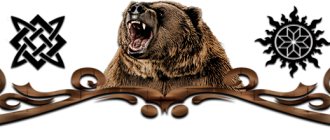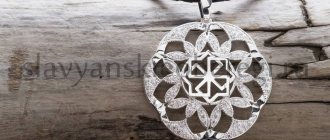Veles God of the Slavs. In the old days, amazing things happened. People worshiped unknown gods, and their signs were seen everywhere, even in the tracks of wild animals. And each providence had its own deity, which by its power directed those who prayed to it. But there were also those who were above the rest, who squeezed the tree of life in the hands of the mighty and gave breath to their land by force. Such were the elder Gods, bearers of this world within and without, and who themselves were this world and its meaning.
Omniscient and omnipotent gods were born from endless mountains and from the peals of menacing thunder, while others even emerged from the wombs of unknown and outlandish animals. And the bright Veles stepped on human land in such a way - from the womb of a heavenly cow that she swallowed the bones of a magical pike. And he appeared before the eyes of the mighty gods, like a bear with a human face and able to speak between light and darkness. And the forefather gods and their children bowed their knees before the clear face of the new deity, who was henceforth destined to guard the path of souls and guard the gates of the worlds.
Veles is a primordially Slavic pagan god who patronizes daily life and all human affairs. Nothing happened without his knowledge: birds did not soar in the sky, ants did not crawl on the ground. People praised their defender and just judge, the giver of wisdom and knowledge, and wore his silver signs, because the power of Veles flowed like a clear river through the silver amulets. Born Zemun, a cow grazing in the heavenly meadows, the god Veles himself did not forget to protect and graze the clouds and human cattle.
They believed that in the form of a human, the clear Veles in the heavenly palaces, like a flock of clouds, drove the winds that danced to the sound of his pipe, and on human earth in the form of a bear in the palaces of the forest and dense forests he protected human cattle from animals and thieves. Therefore, they revered him especially and cajoled him, so that on a rainy day the god Veles would drive away the clouds from the luminary and illuminate the earth and so that the cattle would remain intact in the summer.
The god Veles, playing the flute, summoned the northern, cold and warm winds, living in the rustle of field grasses and dense forests, into a wild round dance. And the winds danced around the clear god and carried out his will. His traces were covered so that no one would be welcome or an enemy would follow the omniscient. And when Veles, driven by his irresistible passion, kidnapped the wife of his brother named Perun, the winds hid the traces of his master and covered up all the paths to the palaces of his monastery. The beautiful Dodola gave birth to a wild and strong son, Yarilo. For which Perun the Supreme cursed his beloved wife and Veles along with her, tearing him apart and throwing him to human land. And the pipe of bright-eyed Veles, hitting the ground, scattered into pieces and it sprouted in the ground as reeds, from which people began to make pipes and play, in order to summon the wind to help their god.
Who is Veles
The sign belongs to the god Veles, one of the most famous representatives of the Slavic pantheon. He controlled the elements and the world of fauna. He was considered the patron saint of livestock and domestic animals. Artists often depicted him as a large bear or bull. God knew how to turn into an animal. Its main symbol, the Veles amulet, is very similar to a bull.
The most important act of God is to give movement to the created world. He became the cause of a series of nights and days, joys and sorrows.
Veles taught people to live, overcome obstacles, solve problems and negotiate without using force.
Pagan god Veles
Known for his patronage of merchants, he helped conclude contracts, and gave people knowledge of the essence of the law. He was a great sorcerer and scientist, showing art and science to humanity.
After being expelled from the divine city of Prav, he became the guardian of the world of the dead. Veles decided the fate of the dead and escorted them to the new monastery.
Origin of the name of the star
Each Slavic god had its own star, which personified the number of the deity. Veles was patronized by six. Therefore, a star consisting of two triangles was assigned as his figure. Later, it began to symbolize the struggle of opposites of Veles, who for many years lived on the edge of worlds and decided the fate of people.
Seal of Solomon
The second name of the hexagram appeared when the Persian peoples adopted it. They did not introduce it into their own culture, but brought it as a gift to the Jews.
Pendant in the form of the seal of Solomon
The Jews called the sign the Seal of Solomon. This name comes from the appearance of the figure:
- The upper part meant the god Dyya, who personified masculinity and the energy of the sun.
- The lower part of the figure is an identification of the goddess of death Mara. She was also a symbol of the Moon.
The combination of the names of the star and the planet in different languages produced a new name for the sign.
Shield of David
The name of the king of Israel became associated with the star much later. During his reign, King David noticed that his name contained two letters, which at that time were depicted in the form of a triangle. The man considered this a sign, and the Star of Veles acquired a new meaning. He made it his own amulet against evil forces and enemies.
Kabbalists and hexagonal symbolism
At the end of the 17th century, the hexagram was actively used by Kabbalists. According to the interpretation of Judaism, each sign has 77 meanings, of which only one is correct, and the rest are false. The Jewish symbol is built from two triangular figures, one of which points upward with its sharp end, and the second is inverted with a sharp angle downward.
One of the triangles shows the Jews, and the second the goyim. The Jewish star is a way to convey to the world that Jews control all the goyim (Aryans) in the world. Simply put, it turns out that there are not many Jews on earth, but they have a high level of thinking, and on the contrary, there are a lot of goyim, but they are not spiritually developed. In Judaism, the goal is to raise the spirituality necessary to develop the fighting qualities a person needs to survive.
Star in the cultures of the world
Despite the original Slavic roots of the sign, archaeologists find the hexagram on the remains of objects from different peoples.
Israel
Jews did not use the Star of Veles in religious books and amulets. For them it was decorative.
Shield of David on the frieze of the synagogue in Kfar Nahum (Capernaum)
The remains of the sign are depicted in the following places:
- on the facades of buildings - the symbol was found on the Capernaum synagogue;
- on lamps;
- on antique furniture;
- on the decoration of walls and floors - the ruins of a castle were found near Jerusalem, where a hexagram was woven into the mosaic on the floor;
- on jewelry.
India
In India, the star of Veles was called the seal of Vishnu. It had a religious character and personified an ancient deity. Associatively, the figure echoes the story of Rama, who was one of the incarnations of Vishnu and meant a lot to Vedic believers.
Other countries
In the Middle Ages in Germany and France, the sign was used to appear on the cover of the Bible. In Mesopotamia, the star represented evil. Here she was owned by God, who dared to forget about the Light, going over to the side of Darkness.
Star of Veles on Christian frescoes (Greece)
The emergence of symbolism
The first mention of the appearance of symbolism dates back to the Neolithic period. The sign meant the connection between the sky, earth and vegetation. In principle, the meaning has not changed that much over the millennia. However, the very use of the symbol dates back to earlier periods.
Tripoli civilization, which existed back in the 5th millennium BC. marked the pubic area on female figures with a triangular sign. Over time, the image began to be widely used as a decoration for clay utensils. The peak of development of the symbol occurs in the 5th-3rd millennium BC. in the Kopetdag civilization. The walls of numerous buildings were skillfully decorated with symbols in various combinations.
Over time, triangles migrated to the writing of the ancient Sumerians. In pictography, the icon meant the concept of woman. Already after 4 millennia, Pythagoras will give the figure the name tetraxis and endow it with a magical meaning.
Symbol meaning
There is no clear opinion on the interpretation of the ancient sign. The figure was used by different peoples; they gave it their own meaning depending on the culture, position of the country, and faith.
The Slavs believed that the star of Veles provided the owner with balance and the ability to make the right choice.
Experts gave a new name to the figure. They call her Dauda. The sign is the identification of two opposites. The fact is explained by the presence of two triangles directed in different directions. Another interpretation is connected with the life of Veles after exile in the space between the world of the living and the dead. His eternal struggle between opposites is captured in this symbol.
Reflecting Evil
According to legends, the basilisk of Veles was defeated by Alexander the Great. He reflected the animal's destructive gaze with the help of a mirror. Since then, the hexagram has been used as a talisman against evil spirits, dark magic and curses. The ancestors believed that the figure was able to repel any witchcraft and preserve the life and health of the owner. The amulet is worn on the body, woven into the pattern of clothing, and hung on the walls of the home.
Alexander the Great defeated the Basilisk Veles
The interaction of the star with the energy of magic gave rise to a new interpretation of the symbol. Thus, according to the ancestors, constant wearing of the sign allows one to discover magical abilities and hidden knowledge.
Dark meaning
Amulet of Veles
Another opinion about the sign of the ancient god of animals is the personification of evil. Myths claim that the owner of the figure was expelled from Prav for using black magic, with the help of which he harassed many people. This is how the negative meaning of the symbol was formed.
Amulet Serpentine
It is important to remember that there is no evil without good, and vice versa. And approach faith taking this fact into account.
Amulet Triglav
Applying star symbols to the skin
At the present stage, the tattoo world widely uses the Star of David. At some point, a tattoo depicting a six-pointed star was applied by sailors as a protective sign. It was believed that the shield could protect against death on the water and help to return home unharmed. The analogy with the Veles seal is clearly visible here. The Slavs believed that Veles was the patron of all elements, and also favored travelers, protecting them from all kinds of natural disasters and attacks by wild animals.
Another meaning of a six-pointed star tattoo is disagreement with the political regime, which is why it could often be found on the chests and shoulders of prisoners. Today, such a tattoo is interpreted as:
- combination of masculine and feminine principles;
- harmony of soul and body;
- good and evil.
The interpretation is not so easy to understand because some sources say that this is a sign of harmonization, while others attribute it to satanic symbols. If you decide to put this symbol on your body, you should think about your essence. The swastika almost always has a contradictory meaning. The main thing is how strong a person is spiritually. The sign will have a positive effect on one person, becoming a kind of engine, while on the other it will completely ruin it and bring only destruction into his life.
Other artifacts of Veles
Knowledge about other talismans of the ancient god allows you to enhance the effect of the star, understand the essence of Veles’s deeds, and open up new opportunities. The most famous artifacts of the animal god:
- The Veles amulet, which is a schematic representation of a bull, promotes self-improvement, discovers new talents, and helps achieve goals. Wearing a talisman for a long time allows you to develop magical abilities, just like a star. The amulet gives the opportunity for foresight and communication with dead people.
- Bearpaw was created to accompany warriors and enhance their abilities. The talisman gives strength to overcome difficult life circumstances, protects the owner from sorrows and troubles. It will help on a long journey and will reflect the malicious intentions of thieves and scammers. Allows you to strengthen your position at work.
- The Serpentine amulet is a double-sided pendant. One side of it symbolizes light deities, the other - dark ones. The talisman will protect from enemies and envious people, and will ward off evil forces. It will help you withstand the trials of fate and lead you to the right decisions. Indispensable for work - it allows you to assess the situation from different angles.
- Triglav symbolizes the connection and eternal interaction of three worlds - Hell, Paradise and the world of the living. It suits creative people. The amulet promotes inspiration and prevents you from falling into despair.
The ancient god is known for his deeds. In some countries he is the embodiment of evil, in others - a symbol of the struggle for light. Its artifacts are important in many cultures. The Star of Veles shows the very essence of the actions and thoughts of God and is considered the main one among other symbols.
Slavic symbolization
The Jewish sign of the Star of David was borrowed from the Slavic people. The Veles seal was considered the most powerful amulet among the Slavs. An amulet with this symbol could protect against any evil. Veles was considered the deity closest to people. This is the only god who has comprehended both the dark side and the light side. According to legend, when Perun expelled him from the heavenly kingdom, Veles ended up in the world of Navi. Here his soul became an abode for evil, but he was able to control his dark side. For a long time he controlled the souls of the dead and demons.
The amulet can protect from any evil
The Star of David was interpreted as a combination of good and evil. This definition most accurately describes the human essence, in which two principles are always fighting. Later, with the advent of Christianity, they began to say that an angel sits on one shoulder of a person, who is trying with all his might to keep him from temptations and bad deeds, and on the other is a demon.
The Veles ring was worn mostly by magicians and people from the upper classes. It was believed that the hexagram endows a person with extraordinary strength, wisdom, and is capable of awakening hidden talents. A personality must constantly grow above itself, but this does not happen immediately, but gradually. For complete harmonization, a person must work hard on himself.











